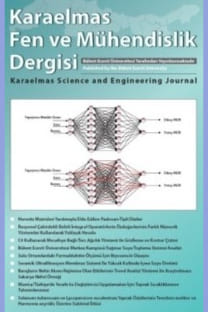Easy Way for Removal of Methylene Blue with Low-Cost Biosorbent
Ucuz Biyosorbent ile Metilen Mavisinin Uzaklaştırılması İçin Kolay Yol
___
Abbasi, M., Asl, NR. 2008. Sonochemical degradation of Basic Blue 41 dye assisted by nanoTiO2 and H2 O2. J. Hazard. Mater.153: 942–947.Annadurai, G., Juang, RS., Lee, DJ. 2001. Adsorption of rhodamine 6G from aqueous solutions on activated carbon, J. Environ. Sci. Health. A. 36 (5): 715-725.
Bingöl, D., Karayünlü Bozbaş, S. 2012. Removal of Lead (II) from Aqueous Solution on Multiwalled carbon nanotube by using response surface methodology. Spectrosc. Lett. 45: 324- 329.
Deniz, F. 2013. Optimization of methyl orange bioremoval by Prunus amygdalus L. (almond) shell waste: Taguchi methodology approach and biosorption system design. Desalin. Water Treat., 51: 7067-7073.
Gulen, J., Aroguz, AZ., Dalgın, D. 2005. Adsorption kinetics of azinphosmethyl from aqueous solution onto pyrolyzed horseshoe sea crab shell from the Atlantic Ocean. Bioresource Technol. 96: 1169–1174.
Hakimelahi, M., Moghaddam, MRA., Hashemi, SH. 2012. Biological Treatment of Wastewater Containing an Azo Dye Using Mixed Culture in Alternating Anaerobic/Aerobic Sequencing Batch Reactors. Biotechnol. Bioprocess. Eng. 17: 875-880.
Hameed, BH. 2008. Equilibrium and kinetic studies of methyl violet sorption by agricultural waste, J. Hazard. Mater. 154: 204-212.
Haque, E., Jun, JW., Jhung SH. 2011. Adsorptive removal of methyl orange and methylene blue from aqueous solution with a metal-organic framework material, iron terephthalate (MOF-235). J. Hazard. Mater. 185: 507-511.
Hines, WW. Montgomery, D.C., 1990. Probability and Statistics in Engineering and Management Science, John Wiley and Sons.
Jalil, AA., Triwahyono, S., Yaakob, MR., Azmi, ZZA., Sapawe, N., Kamarudin, NHN., Setiabudi, HD., Jaafar, NF., Sidik, SM., Adam, SH., Hameed, BH. 2012. Utilization of bivalve shell-treated Zea mays L. (maize) husk leaf as a lowcost biosorbent for enhanced adsorption of malachite green. Bioresource Technol. 120 : 218–224.
Kamba, AS., Ismail, M., Ibrahim, TAT., Zakaria, ZAB. 2013. Synthesis and characterization of calcium carbonate aragonite nanocrystals from cockle shell powder (Anadara granosa). J. Nanomater. 2013: 1–9.
Karayünlü Bozbaş, S., Boz,Y. 2016. Evaluating the optimum working parameters for the removal of methyl orange from aqueous solution based on a statistical design. Desalin. Water Treat. 57: 7040-7046.
Kazemi, SY., Biparva, P., Ashtiani, E. 2016. Cerastoderma lamarcki shell as a natural, low cost and new adsorbentto removal of dye pollutant from aqueous solutions: Equilibrium and kinetic studies. Ecol. Eng. 88: 82–89.
Liu, F., Zou, H., Hu, J., Liu, H., Peng, J., Chen, Y., Lu, F., Huo, Y. 2016. Fast removal of methylene blue from aqueous solution using porous soy protein isolate based composite beads. Chem Eng J. 287: 410–418.
Mangat, K., Kaur, S. 2014. Efficient removal and separation of anionic dyes from aqueous medium by the application of reverse micelles of cationic surfactants, Desalin. Water. Treat. 52 :3555–35631.
Mathialagan, T., Viraraghavan, T. 2005. Biosorption of pentachlorophenol by fungal biomass from aqueous solutions: A factorial design analysis. Environ. Technol. 26: 571-579.
Özbay, N., Yargıç, AF., Yarbay-Şahin, RZ., Önal, E. 2013. Full factorial experimental Design analysis of reactive dye removal by carbon adsorption. J. Chem. 13:1-13.
Pavan, FA., Gushikem, Y., Mazzocato, AC., Dias, SLP., Lima, EC. 2007. Statistical design of experiments as a tool for optimizing the batch conditions to methylene blue biosorption on yellow passion fruit and mandarin peels, Dyes Pigments. 72: 256-266.
Sleiman, M., Vildozo, DL., Ferronato, C., Chovelon, JM. 2007. Photocatalytic degradation of azo dye Metanil Yellow: optimization and kinetic modeling using a chemometric approach, Appl. Catal. B. 77: 1–11.
Srinivasan, A., Viraraghavan, T. 2010. Oil removal from water by fungal biomass: A factorial design analysis, J. Hazard. Mater. 175: 695-702.
Sudarjanto, G. Keller-Lehmann, B., Keller, J. 2006. Optimization of integrated chemical–biological degradation of a reactive azo dye using response surface methodology, J. Hazard. Mater. 138: 160–168.
Suteu, D., Bilba, D., Doroftei, F., Malutan, T. 2011. Sorption of brilliant red HE-3B reactive dye from aqueous solution onto seashells waste: equilibrium and kinetic studies. Separ. Sci. Technol. 46: 1462–1471.
Tizi, H., Berrama, T., Kaouah, F., Bendjama, Z. 2013. Study of the conditions of activated carbon preparation from an agriculture by-product for 4BA elimination in aqueous solution using full factorial design, Desalin. Water Treat. 51:7286-7295
Turan, NG., Elevli, S., Mesci, B. 2011. Adsorption of copper and zinc ions on illite: Determination of the optimal conditions by the statistical design of experiments. Appl. Clay Sci. 52 (2011) 392-399.
Zhu, MX., Lee, L., Wang, HH., Wang, Z. 2007. Removal of an anionic dye by adsorption/ precipitation processes using alkaline white mud. J. Hazard. Mater. 149: 735–741.
- ISSN: 2146-4987
- Yayın Aralığı: 3
- Başlangıç: 2011
- Yayıncı: ZONGULDAK BÜLENT ECEVİT ÜNİVERSİTESİ
Tan (F(ξ)/2)-Expansion Method for Traveling Wave Solutions of the Variant Bussinesq Equations
Taşkömür Havzasındaki Tasman Oluşumlarının Yeryüzü Üzerindeki Etkilerinin CBS ile Belirlenmesi
Ankara İli Atmosferik Polen Konsantrasyonunun Genel Eğilimi
AYDAN ACAR ŞAHİN, ŞENOL ALAN, AYŞE KAPLAN, EDİBE ÖZMEN BAYSAL, CAHİT DOĞAN, NUR MÜNEVVER PINAR
Variant Bussinesq Denklemlerinin Hareket Eden Dalga Çözümleri için Tan F ξ /2 Açılım Metodu
Kesirli Kısmi Diferansiyel Denklem Sistemlerinin Yaklaşık Analitik Çözümleri
Polietersülfon (PES) Membran Sentezinde Koagülasyon Ortamının Etkileri
Evri̇m ÇELİK MADENLİ, ÖZGÜR ÇAKMAKCI, KEMAL AKTAŞ, Ulaş AYGÖR
Temel ÖZTÜRK, Hıdır AYYILDIZ, Ergül MEYVACI, Melahat GÖKTAŞ
İnsansız Hava Araçları İçin Yapay Arı Kolonisi Algoritması Kullanarak
Tiyosemikarbazon İçeren Vis-Dioksim Ligandının Ni(II) Kompleksinin DNA Etkileşimlerinin İncelenmesi
Burak COBAN, İlknur BABAHAN, Cengiz SAĞLAM, Nursel ESER
